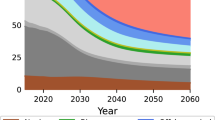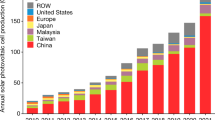Abstract
Concentrating solar power (CSP) capacity has expanded slower than other renewable technologies and its costs are still high. Until now, there have been too few CSP projects to derive robust conclusions about its cost development. Here we present an empirical study of the cost development of all operating CSP stations and those under construction, examining the roles of capacity growth, industry continuity, and policy support design. We identify distinct CSP expansion phases, each characterized by different cost pressure in the policy regime and different industry continuity. In 2008–2011, with low cost pressure and following industry discontinuity, costs increased. In the current phase, with high cost pressure and continuous industry development, costs decreased rapidly, with learning rates exceeding 20%. Data for projects under construction suggest that this trend is continuing and accelerating. If support policies and industrial structure are sustained, we see no near-term factors that would hinder further cost decreases.
This is a preview of subscription content, access via your institution
Access options
Access Nature and 54 other Nature Portfolio journals
Get Nature+, our best-value online-access subscription
$29.99 / 30 days
cancel any time
Subscribe to this journal
Receive 12 digital issues and online access to articles
$119.00 per year
only $9.92 per issue
Buy this article
- Purchase on Springer Link
- Instant access to full article PDF
Prices may be subject to local taxes which are calculated during checkout




Similar content being viewed by others
References
Trancik, J. Back the renewables boom. Nature 507, 300–302 (2014).
Lilliestam, J. & Hanger, S. Shades of green: centralisation, decentralisation and controversy among European renewable electricity visions. Energy Res. Soc. Sci. 17, 20–29 (2016).
Williges, K., Lilliestam, J. & Patt, A. Making concentrated solar power competitive with coal: the costs of a European feed-in tariff. Energy Policy 38, 3089–3097 (2010).
Renewable Power Generation Costs in 2014 (International Renewable Energy Agency (IRENA), 2015).
Photovoltaics Report (Fraunhofer ISE, 2016).
Rubin, E., Azevedo, I., Jaramillo, P. & Yeh, S. A review of learning rates for electricity supply technologies. Energy Policy 86, 198–218 (2015).
Neij, L. Cost development of future technologies for power generation - A study based on experience curves and complementary bottom-up assessments. Energy Policy 36, 2200–2211 (2008).
Viehbahn, P., Lechon, Y. & Trieb, F. The potential role of concentrated solar power (CSP) in Africa and Europe. Energy Policy 39, 4420–4430 (2011).
The Power to Change: Solar and Wind Cost Reduction Potential to 2025 (International Renewable Energy Agency (IRENA), 2016).
Mehos, M. et al. On the Path to SunShot: Advancing Concentrating Solar Power Technology, Performance, and Dispatchability (National Renewable Energy Laboratory (NREL), 2016).
Trieb, F., O’Sullivan, M., Pregger, T., Schillings, C. & Krewitt, W. Characterisation of Solar Electricity Import Corridors from MENA to Europe (German Aerospace Centre (DLR), 2009).
Hinkley, J. et al. Concentrating Solar Power—Drivers and Opportunities for Cost-Competitive Electricity (CSIRO, 2011).
Feldman, D., Margolis, R., Denholm, P. & Stekli, J. Exploring the Potential Competitiveness of Utility-Scale Photovoltaics Plus Batteries with Concentrating Solar Power 2015–2030 (National Renewable Energy Laboratory (NREL), 2016).
Nemet, G. Beyond the learning curve: factors influencing cost reductions in photovoltaics. Energy Policy 34, 3218–3232 (2006).
Gallagher, K., Grübler, A., Kuhl, L., Nemet, G. & Wilson, C. The energy technology innovation system. Annu. Rev. Environ. Resour. 37, 137–162 (2012).
Grübler, A., Nakicenovic, N. & Victor, D. Dynamics of energy technologies and global change. Energy Policy 27, 247–280 (1999).
Ferioli, F., Schoots, K. & van der Zwaan, B. Use and limitations of learning curves for energy technology policy: a component-learning hypothesis. Energy Policy 37, 2525–2535 (2009).
del Río, P. The dynamic efficiency of feed-in tariffs: the impact of different design elements. Energy Policy 41, 139–151 (2012).
Martinot, E., Wiser, R. & Hamrin, J. Renewable Energy Markets and Policies in the United States (Center for Resource Solutions, 2005).
Elefant, C. Reviving PURPA’s Purpose (Law offices of Carolyn Elefant, 2015).
Baharoon, D. A., Rahman, H. A., Omar, W. Z. W. & Fadhl, S. O. Historical development of concentrating solar power technologies to generate clean electricity efficiently—a review. Renew. Sustain. Energy Rev. 41, 996–1027 (2015).
Cohen, G., Mancini, T., Wilkins, T., Morse, F. & Kearney, D. The History of American CSP (CSP Today USA 2012, 2012).
de la Tour, A., Glachant, M. & Ménière, Y. Economic Analysis of the CSP Industry (CERNA, Mines ParisTech, 2010).
Martìn, H., de la Hoz, J., Velasco, G., Castilla, M. & Garcìa de Vicuña, J. L. Promotion of concentrating solar power (CSP) in Spain: performance analysis of the period 1998–2013. Renew. Sustain. Energy Rev. 50, 1052–1068 (2015).
Frisari, G. & Feás, J. The Role of Public Finance in CSP (Climate Policy Initiative, 2014).
Lilliestam, J. et al. in Solar Power: Technologies, Environmental Impacts and Future Prospects (ed. Stephen, B. ) 23–56 (Nova, 2014).
del Río, P., Peñasco, C., Mir-Artigues, P., Veum, K. & Jansen, J. Appropriate Policy Portfolios for still Maturing Renewable Electricity Technologies. The Cases of Concentrating Solar Power and Wind Offshore (Towards2030 project, 2016).
Business Plan Financial Restructuring Proposal (Abengoa, 2016).
Annual Report 2015 (Abengoa, 2016).
Rioglass Solar has Signed an Agreement with Schott Solar CSP GmbH for the Acquisition of its Receiver Business (Rioglass, 2015); http://www.rioglass.com/?p=2576
Abengoa Reduce su Participación el el Grupo Rioglass Solar al 15% (El Comercio, 2016); http://www.elcomercio.es/economia/empresas/201607/30/abengoa-reduce-participacion-grupo-20160730003244-v.html
Solar Thermal and Concentrated Solar Power Barometer (Eurobserver, 2014).
Solar Millennium AG Files for Opening of Insolvency Proceedings (Solar Millennium, 2011); http://www.solarmillennium.de/english/press/press-releases/2011-12-21-insolvency-filing.html
Wesoff, E. The Sunset of Solel, Siemens and Solar Trough CSP Technology (Green Tech Media, 2013); https://www.greentechmedia.com/articles/read/The-Sunset-of-Solel-Siemens-CSP-and-Solar-Trough-Technology
China NDRC Formally Releases Official Notice on Benchmark Feed-in-Tariff Policy of CSP Industry (CSP Plaza, 2016); http://en.cspplaza.com/china-ndrc-formally-releases-official-notice-on-benchmark-feed-in-tariff-policy-of-csp-industry.html
SolarReserve Eyes Chile CSP Wins as Surplus PV Disrupts Markets (CSP Today, 2016); http://social.csptoday.com/markets/solarreserve-eyes-chile-csp-wins-surplus-pv-disrupts-markets
Concentrating Solar Power Projects by Country (NREL, 2016); http://www.nrel.gov/csp/solarpaces/by_country.cfm
CSP World Map (CSP world, 2015); http://www.cspworld.org/cspworldmap
CSP Today Global Tracker (CSP today, 2016); http://social.csptoday.com/tracker/projects
Yearly Average Rates (US Forex, 2016); http://www.usforex.com/forex-tools/historical-rate-tools/yearly-average-rate
GDP Deflator (Eurostat, 2016); http://ec.europa.eu/eurostat/tgm/table.do?tab=table&plugin=1&language=en&pcode=teina110
Orden IET/1045/2014 (Boletín oficial del estado, 2014).
Sikhonasa, Q. Global Review of CSP Technologies (Univ. Cape Town, 2011).
Solar Thermal Electricity Global Outlook 2016 (Greenpeace & ESTELA, 2016).
Neij, L. et al. Experience Curves: A Tool for Energy Policy Assessment (Lund University, 2003).
Technology Roadmap. Concentrating Solar Power (International Energy Agency (IEA), 2010).
SunShot Vision Study (US Department of Energy (DOE), 2012).
Schinko, T. & Komendantova, N. De-risking investment into concentrated solar power in North Africa: impacts on the costs of electricity generation. Renew. Energy 92, 262–272 (2016).
Labordena, M., Patt, A., Bazilian, M., Howells, M. & Lilliestam, J. Impact of political and economic barriers for concentrating solar power in sub-Saharan Africa. Energy Policy 102, 52–72 (2017).
Ondraczek, J., Komendantova, N. & Patt, A. WACC the dog: the effects of financing costs on the levelized cost of solar PV power. Renew. Energy 75, 888–898 (2015).
Acknowledgements
Funding for this work came from a European Research Council Consolidator Grant (grant number 313553).
Author information
Authors and Affiliations
Contributions
J.L. designed the study and drafted the article; J.L. and M.L. gathered the data; J.L. and S.P. analysed the data; S.P. generated the figures; all authors worked with the final manuscript; A.P. supervised the grant.
Corresponding author
Ethics declarations
Competing interests
The authors declare no competing financial interests.
Supplementary information
Supplementary Information
Supplementary Notes 1–6, Supplementary Tables 1–2, Supplementary Figures 1–12 and Supplementary References. (PDF 829 kb)
Supplementary Data 1
Technical and economic data for all operational CSP stations and those currently (as of September 2016) under construction. n.k. = not known. This version of the data and future updated data are also available on www.csp.guru. (XLSX 39 kb)
Rights and permissions
About this article
Cite this article
Lilliestam, J., Labordena, M., Patt, A. et al. Empirically observed learning rates for concentrating solar power and their responses to regime change. Nat Energy 2, 17094 (2017). https://doi.org/10.1038/nenergy.2017.94
Received:
Accepted:
Published:
DOI: https://doi.org/10.1038/nenergy.2017.94
This article is cited by
-
Liquid-based high-temperature receiver technologies for next-generation concentrating solar power: A review of challenges and potential solutions
Frontiers in Energy (2023)
-
Drop-in fuels from sunlight and air
Nature (2022)
-
On the quality of emission reductions: observed effects of carbon pricing on investments, innovation, and operational shifts. A response to van den Bergh and Savin (2021)
Environmental and Resource Economics (2022)
-
Understanding and accounting for the effect of exchange rate fluctuations on global learning rates
Nature Energy (2020)
-
Will policies to promote energy efficiency help or hinder achieving a 1.5 °C climate target?
Energy Efficiency (2019)



